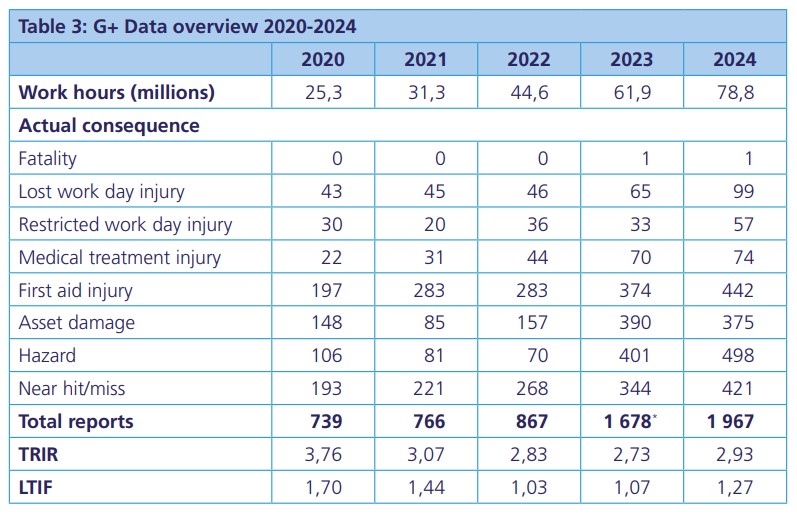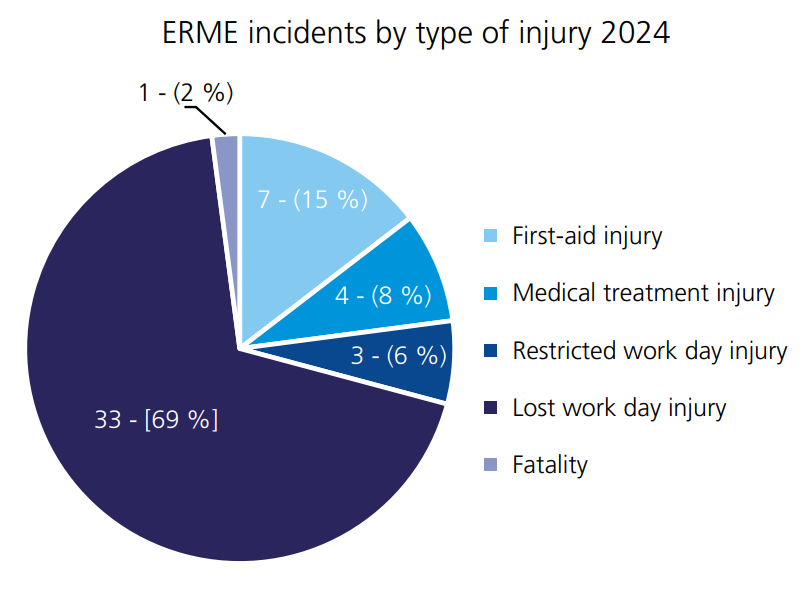The G+ Offshore Wind Health and Safety Organization has released its 2024 Incident Data Report, revealing the rising safety risks in the offshore wind industry.
According to the report, throughout 2024, the industry continued its growth, with hours worked rising to a new high of 79 million—an increase of 27 % on 2023’s 62 million—as multiple sites moved from the final stages of construction into operation. There was a rise in both the total recordable injury rate (TRIR) and the lost time injury frequency (LTIF), with TRIR increasing by 7 %, from 2,73 in 2023 to 2,93 in 2024, and LTIF rising by 19 %, from 1.07 in 2023 to 1.27 in 2024.
Furthermore, all reporting categories (injuries, hazards, near misses, and reports of asset damage) can be tagged as having ‘high potential’, i.e. the greatest likelihood of causing serious harm regardless of the actual consequence. In 2024, high potential cases increased from 11 % to 12 % of the total year on year.

Key facts and figures
1,967 total unique reports, including:
- 42 injuries, 56 asset damage only, 38 near hit/misses and 30 hazards on development sites;
- 403 injuries, 267 asset damage, 279 near hit/misses and 225 hazards on construction sites;
- 228 injuries, 52 asset damage, 104 near hit/misses and 243 hazards on operational sites;
- no reports from sites under decommissioning, and
- 245 out of the 1,967 reports were classified as high potential.
The injuries included:
- 1 fatality;
- 99 lost work day injuries;
- 57 restricted work day injuries;
- 74 medical treatment injuries, and
- 48 incidents resulted in emergency response and medical evacuation (ERME), across all injury severities
Top three work process are:
- lifting operations: 29 injuries, 95 asset damage, 100 near hit/misses and 58 hazards reported.
- routine maintenance: 37 injuries, 25 asset damage, 30 near hit/misses and 86 hazards reported.
- manual handling: 121 injuries, 5 asset damage, 7 near hit/misses and 7 hazards reported.
Injuries resulting in emergency response and medical evacuation
In 2024, 7 % (48) of all injuries resulted in an emergency response or medical evacuation (ERME), higher than in 2023, when 6 % (30 incidents) were classified as ERME. There was also an increase in the number of ERME incidents per million work hours, with this figure rising 26 % from 0,48 in 2023 to 0,61 in 2024.
Breaking down incidents that involved ERME, there were seven first-aid cases, up 133 % from 2023; however, these were largely due to a multiple casualty incident with a more severe injury that triggered the ERME.
In addition, there were four medical treatment cases, down 20% from 2023. Three incidents resulted in restricted work day cases, down 40 % from 2023; and 33 incidents resulted in lost work day injury, up 106 % from 2023. The rise in ERME incidents related to lost work day cases is notable, as is the fact that a third of all lost work day cases that occurred in 2024, 33 out of 99, required ERME.
This fatal event which recorded this year was also classified as ERME In terms of work processes, the process with the highest number of ERME incidents in 2024 was working with hand tools/power tools, with seven incidents, accounting for 15 % of all ERME incidents. This work process saw a sharp rise from 2023, where only one hand tools/power tools ERME incident occurred.
Working at heights (five incidents), walking from A to B (four incidents), and routine maintenance (four incidents) also accounted for a significant proportion of 2024 ERME work processes. Together, these work processes account for 42% of all ERME incidents, with the remainder being spread out across 18 other work processes.

Looking at incident areas, the two areas with the highest number of ERME incidents in 2024 are jack-up vessels/barges and service operation vessels (SOV), both with six incidents each. This is an increase from two incidents in jack-up vessels/barges and four incidents in SOVs in 2023.
CTVs also stand out, with five incidents, up from one incident in 2023. The remaining 31 incidents were spread over 14 incident areas. 27 %, 13 out of 48, of ERME incidents were classified as high potential, higher than the 2024 high potential injury average of 8%, although significantly lower than the 2023, where 43 %,13 out of 30, ERME incidents were classified as high potential.
Looking at incident areas, three incidents were recorded inside a WTG foundation, and two incidents were recorded each for both jack-up vessel/barge and onshore harbour, quay, and pontoons. With regards to work processes, three incidents occurred during working at heights, and two occurred while working with chemicals and hazardous substances. For these high potential ERME incidents, over half, seven incidents, resulted in a lost work day injury, and one resulted in a fatality.
































































